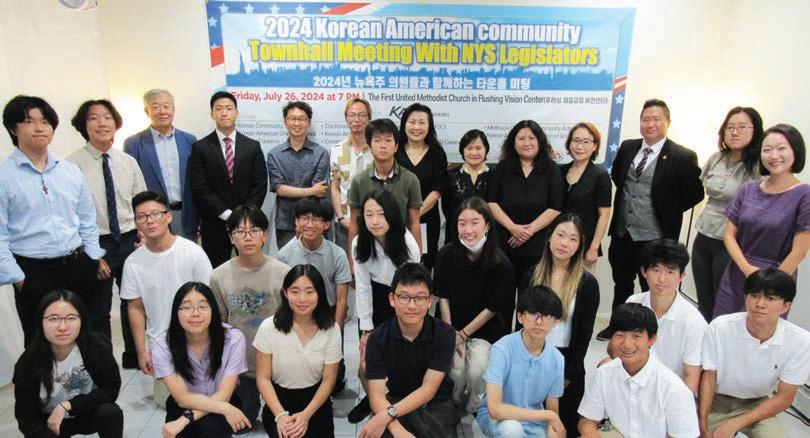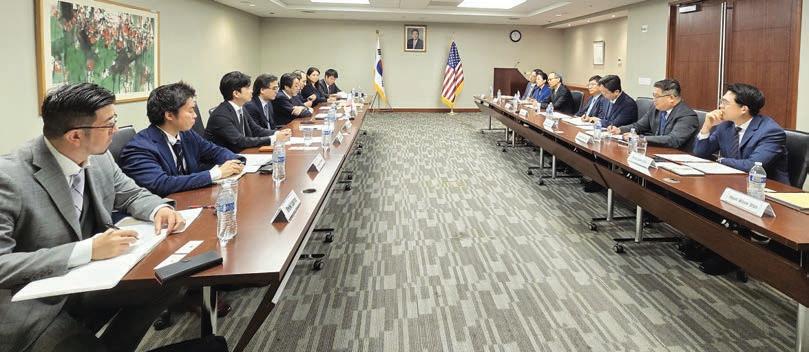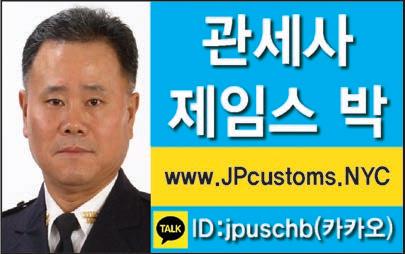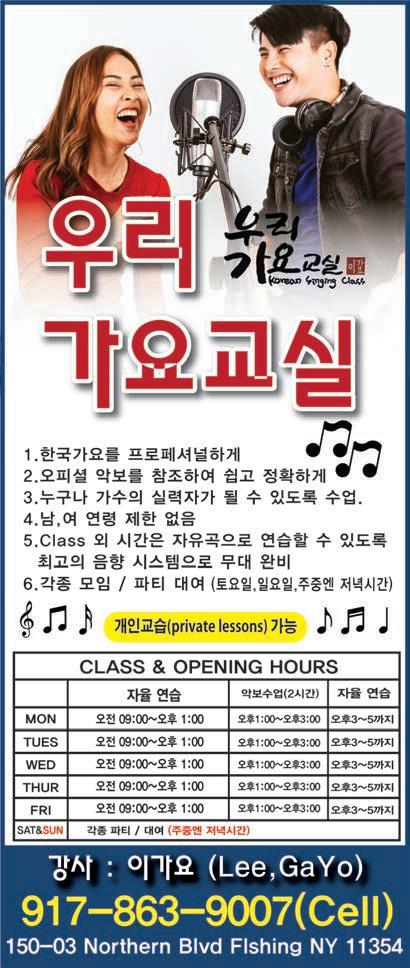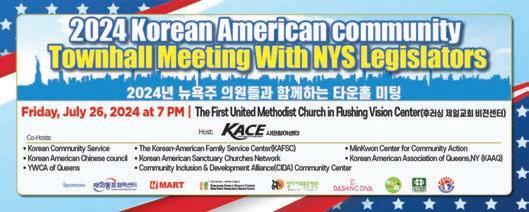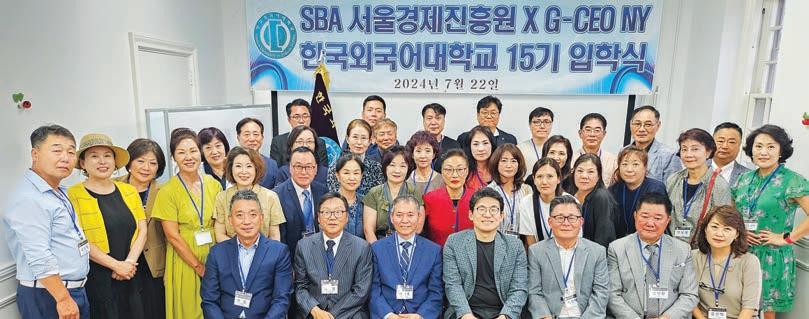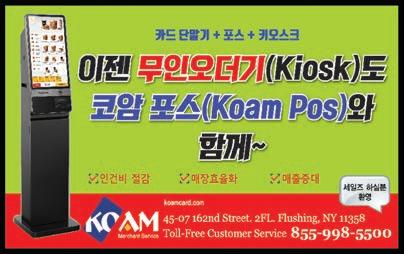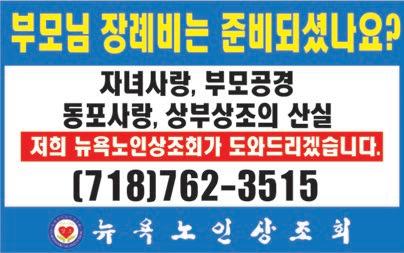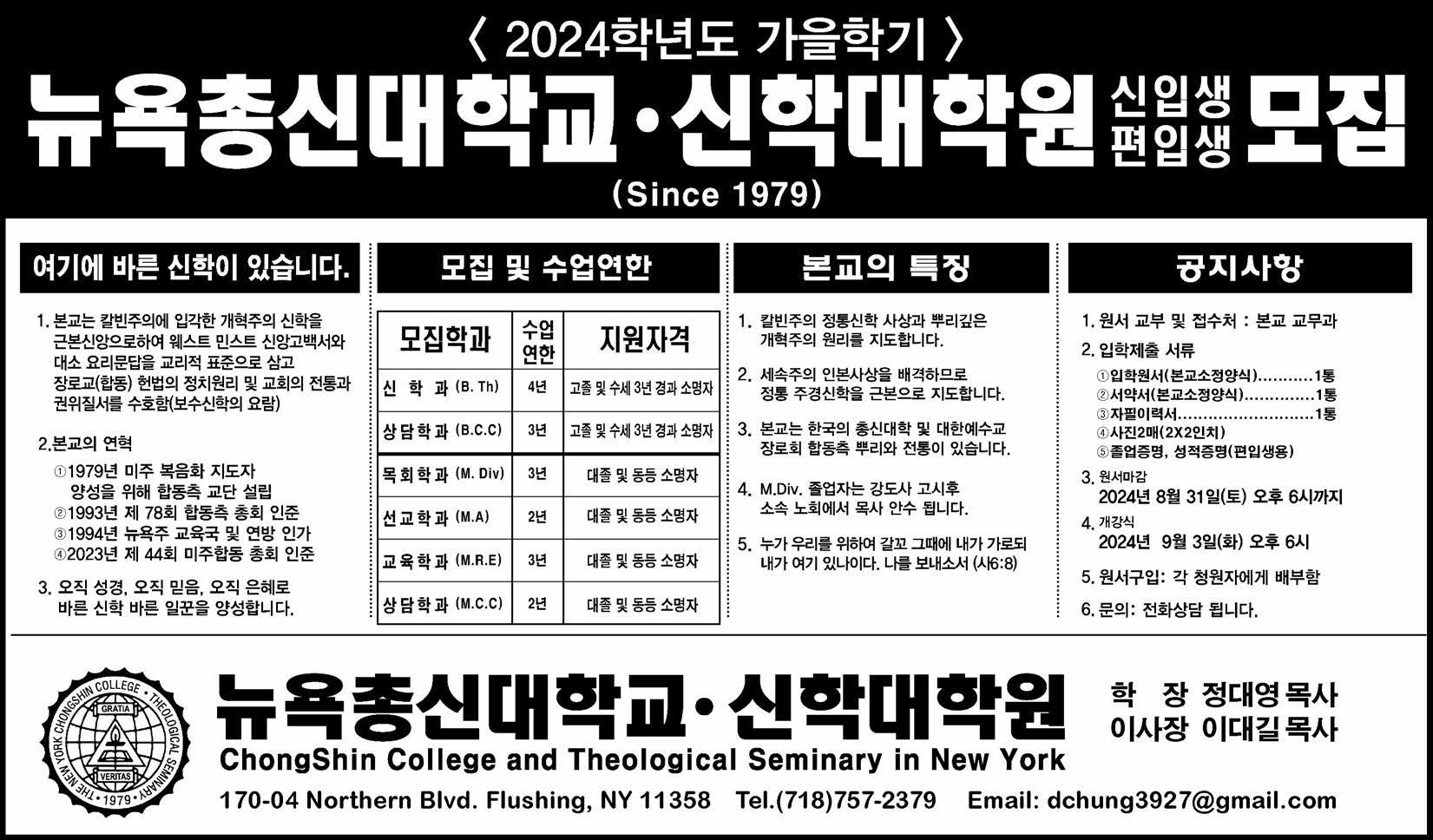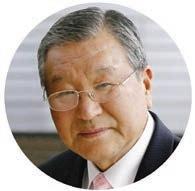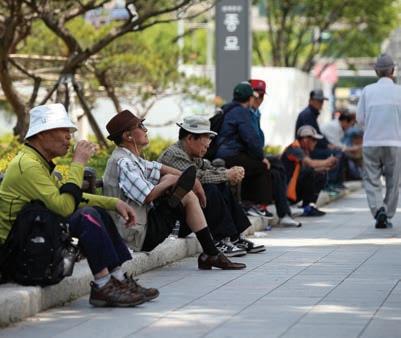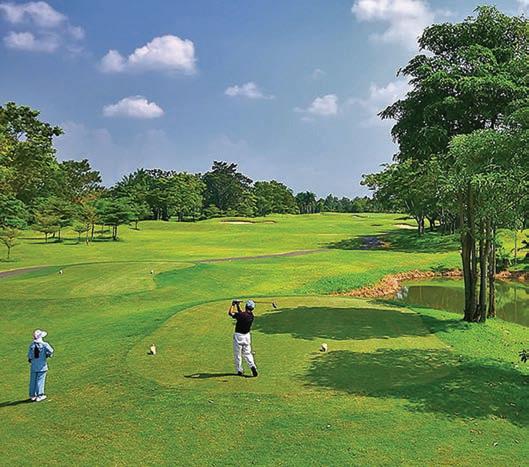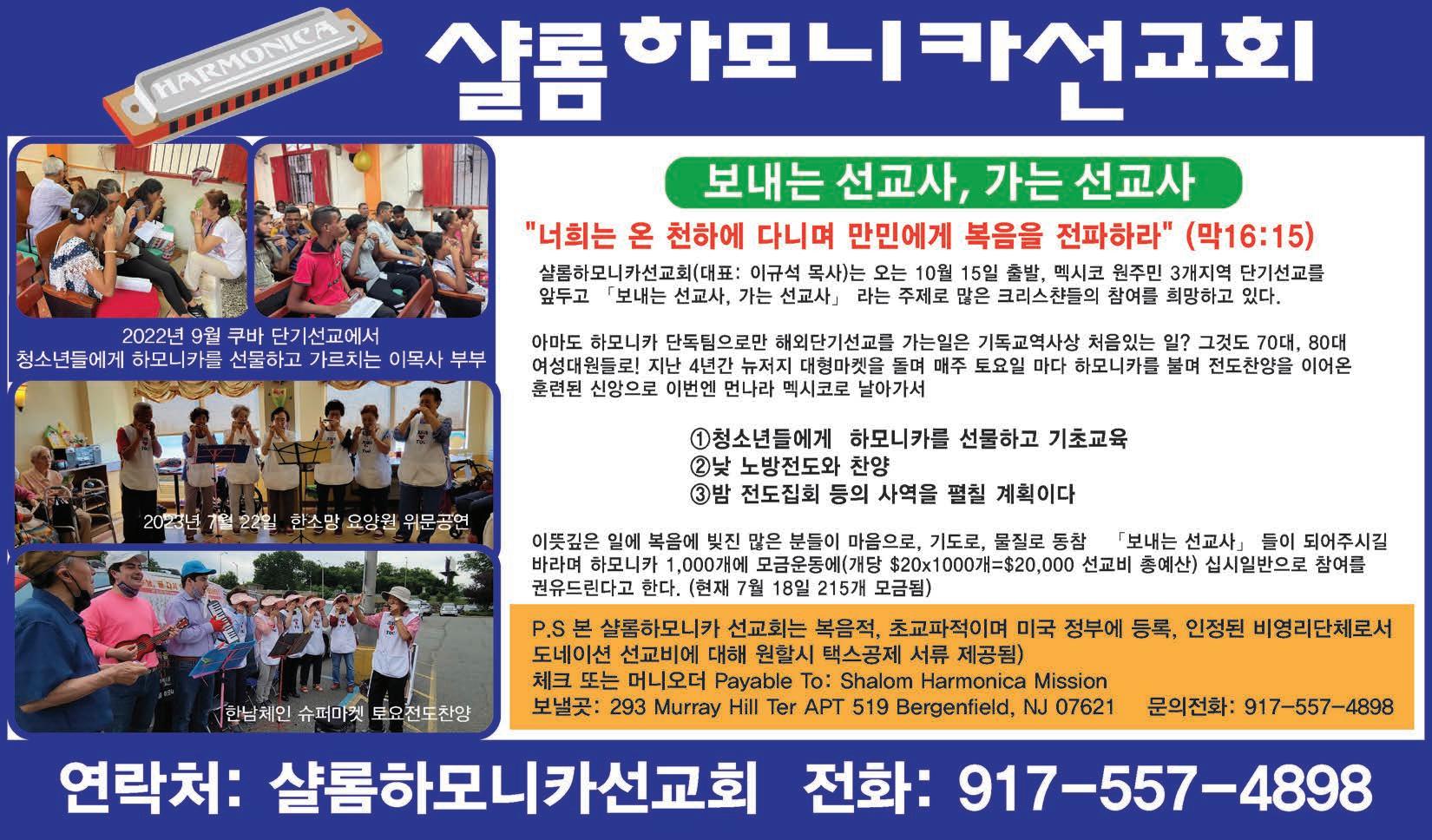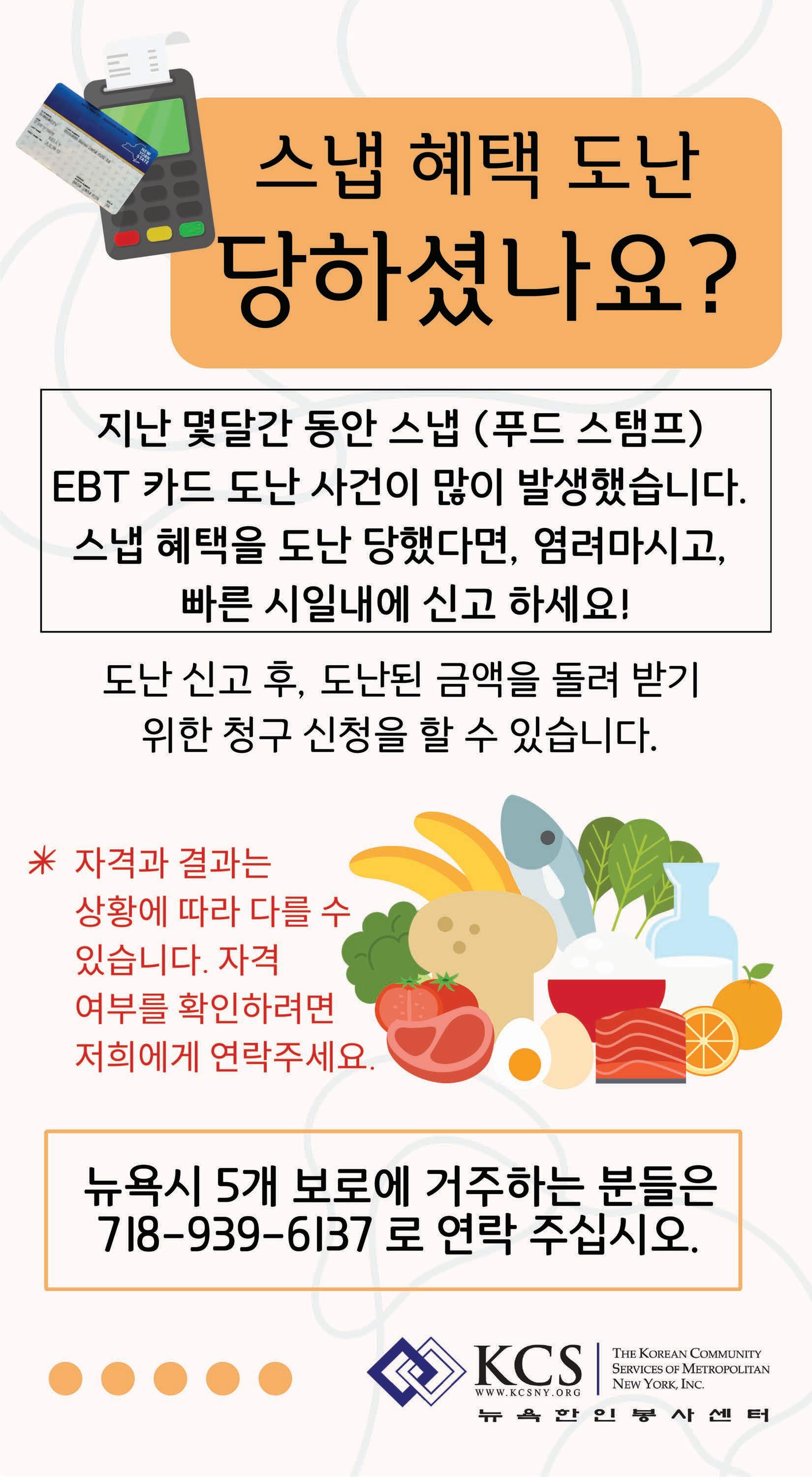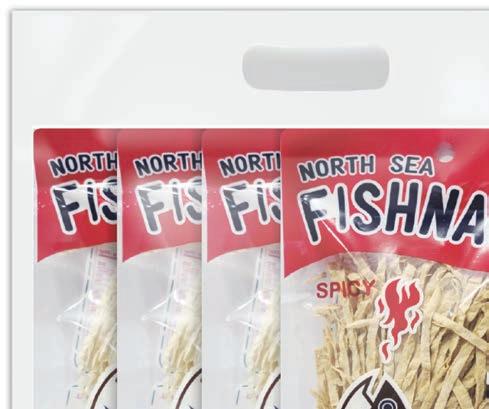시민참여센터(KACE, 대표
김동찬)와 KCS, 민권센터, 퀸즈 YWCA, 가정상담소, 한중미 사
랑협회, 이민자보호교회 네트워
크, 퀸즈한인회, CIDA가 26일 (금) 오후 7시 후러싱제일교회 비
젼센터에서 지역 정치인들과 함
께하는 타운홀 미팅을 갖는다
타운홀 미팅은 동포사회의 주
요 비영리 단체들과 한인회가 커
뮤니티와 관련된 이슈들, 의회에
상정된 각종 법안들을 가지고 지
역 정치인들과 함께 질문하고 토
론 하면서 커뮤니티의 발전을 만
들기 위하여 진행한다.
26일 타운홀 미팅에 참여하는
지역 정치인들은 뉴욕주의회 존
리우 상원의원, 론 김 하원의원, 에드워드 브런스틴 하원의원, 지 나 실리티 하원의원, 그레이스 리 하원의원 이다.
주요 내용은 참여하는 단체들
이 커뮤니티 서비스에 관련하여
시민참여센터와 KCS, 민권센터, 퀸즈 YWCA, 가정상담소, 한중미 사랑협회, 이민자보호교회
퀸즈한인회, CIDA가 26일(금)
오후 7시 후러싱제일교회 비젼센터에서 지역 정치인들과 함께하는 타운홀 미팅을 갖는다. [사진 제공=시민참여센터]
김의환 주뉴욕총영사는 24일 (수) 뉴욕총영사관에서 Mikio
Mori 주뉴욕일본총영사와 한일
총영사관 협력 대화를 마련하고,
양국 총영사관 간 경제, 커뮤니티
등 분야에서의 협력 방안에 대해
논의했다.
김의환 총영사는 한일 양 정상
간의 두터운 신뢰를 바탕으로 한
일관계가 개선되고 한미일 협력
이 강화되고 있는 상황에서, 지난
1년 5개월 동안 Mori 총영사와 돈
독한 우애를 이어오며 일본총영
사관 및 유관기관과 20여 회 넘게
교류해온 점을 기쁘게 생각한다
고 말했다. 김 총영사는 양 총영 사관 간 다양한 분야에서의 협력
을 논의하기 위해 이번 협력 대화 를 제안했다며 이러한 대화의 장 은 이번이 처음으로 이를 통해 대 미 외교의 일선 현장에서의 한일 관계 발전의 기회를 더욱 많이 마 련해 나가자고 말했다.
Mori 총영사는 이번 대화를
제안해 준 김 총영사에 사의를 표
하고, 작년 이후 양 정상 간 셔틀
외교가 재개되면서 정치, 경제, 문 화 등 다양한 분야에서 양국 협력 이 확대되고 있는 만큼, 이번 양 국 총영사관 간 대화가 앞으로의
커뮤니티가 비록 소수계이 지만 미국이 작동하고 있는 방식 을 이해하고 우리에게 필요한 여 러 이슈들을 어떻게 효과적으로 입법부에 전달하여 우리의 권익 을 키우는 수단으로 이 타운홀 미 팅을 활용해야 한다. 또 타운홀 미팅은 한인 커뮤니티 스스로에 대한 교육
한일관계 발전에 보탬이 될 수 있 길 바란다고 말했다.
이날 대화에서는 양측의 각 분 야 영사들 간 발제 및 토론을 갖 고 양국 기업 활동 및 동포 지원 을 위한 그간의 총영사관 활동 경 험을 공유하였으며, 향후 양 총영
사관 간 공동 세미나, 차세대 네
트워킹 포럼 개최 등 협력 방안에 대해 논의했다.
뉴욕총영사관은 앞으로도 관
할지역에서의 한일관계 발전과 한미일 협력 강화 필요성에 대한
미국 내 인식 제고를 위해 계속해 서 노력해나갈 예정이다.
15기 입학식이 22일(월) 플러싱에 있는 GLF에서 열렸다. 이날 신세현 씨를 비롯한 20명 이 입학했다. 15기 강의는 22일 시 작하여 8월 16일 수료한다.
박주열 운영위원장의 사회로 진행된 입힉식은 한국외대 고동 우 주임교수의 환영사, 이상호 총 원우회장, 이현탁직전 총원우회 장, 김영환 강원도민회장의 축사, 박주열 운영위원장의 학사일정 소개 등이 있었다. 22일 입학한 장정희 15기 원우
<A1면에서 계속> 한편 미국 공영매체 NPR과 PBS이 마리스트와 공동으로 등 록 유권자 1천117명을 대상으로 지난 22일 실시해 이날 공개한 여 론조사에서도 트럼프 전 대통령 이 46%를 기록해 45%를 받은 해 리스 부통령에 오차범위(±3.5% 포인트) 내에서 우위에 있었다. 다만 3자 후보를 포함한 다자 가상 대결에서 트럼프 전 대통령 과 해리스 부통령은 42%로 동률 을 기록했다. 전체 응답자의 87%는 바이든
령의 후보
6·25 Blended: MyKoreanConnection
AspenMeyer(AcellusOnlineAcademy, MO)
Korea, a land of rolling valleys, green meadows, towering mountains, and a passionate, vibrant people.
A land filled with beauty and a thoughtful, intentful culture, but also a nation that was pillaged and enslaved for decades switching from one oppressive ruler to the next until suffering famine, poverty, and destruction was looked upon as an inescapable norm.
However, as World War II came to an end, the Korean people felt a new sense of hope that they might finally reconnect as one independent nation and become the masters of their own fate. Unfortunately, this dream would turn out to be short-lived, as the Korean people switched from a suppressive, totalitarian Japanese regime to a severed state with mentors who only had their best interests at heart.
It was 4 A.M in the twilight hours of the rainy Sunday morning of June 25th, 1950, when just North of the 38th Parallel, in the secluded Ongjin Peninsula, the North Korean units launched a surprise artillery barrage against the Republic of Korea, igniting the Korean War.
However, the breeding ground of the conflict had begun developing far before the initial attack, involving the issues that surrounded the collapse of the Japanese Empire (Stueck 61).
On August 8th, 1945, two days following the US atomic bombing on Hiroshima, the Soviet Union declared war on Japan and entered the Korean Peninsula. The US, desperate to contain communist influence and retain their position on the highly geopolitical peninsula, suggested splitting Korea along the 38th Parallel, each side beginning a trusteeship with their half, and ultimately working towards stabilizing, and reuniting the two halves. Unfortunately, in the process of furthering their foreign agenda, the US and Soviet Union’s increased tension led them to refuse to acknowledge the

wants of the people, fostering an environment of unrest and intense yearning for reunification (Matray). While the US and USSR are partially at fault for disregarding the wants of the people, the Korean citizens (being under the suppressive control of Japan for decades) experienced a lack of strong political leaders who could be tolerant of the opposing ideology, who could best represent the will of the people, and who could fight for an independent, free Korea. This lack of indigenous political institutions only helped to fortify the beliefs from the Soviet and American policy makers in a need for external dominance in Korean decisionmaking.
Ultimately, the disregardance of the people’s ideas and lack of strong indigenous political leaders only increased the longing for reunification from Koreans, and by the beginning of 1950 it was clear to both sides that the only route to unification was by utilizing force due to the ideological divergence that occurred between the North and South, and the worsening communication conditions between the US and USSR (Stueck 66-69).
On July 1, 1950, the first US ground troops arrived to the aid of the Republic of Korea to help defend them from the offensive tactics of the Democratic People’s Republic of Korea
(Vergun). President Harry S. Truman stated in later memoirs on American intervention in the Korean War, “Communism was acting in Korea just as [Adolf] Hitler, [Benito] Mussolini, and the Japanese had acted 10, 15, and 20 years earlier… if North Korean aggression went unchallenged the world was certain to be plunged into another World War. (qtd. in Matray)”
This need of prevention
changed their goal from reinforcing the 38th Parallel, to attempting to reunite the nation under South Korean governance (Stueck 98). As a result, Mao Zedong, Chairman of the Chinese Communist Party, warned the US that if they crossed the 38th Parallel, China would intervene on behalf of their North Korean counterparts to maintain it’s regional credibility, good relations with the USSR, and physical barrier between them and South Korea due to their opposing
multifaceted decisions that go into life changing events, and how the effects of one decision can impact yourself and others future life, liveliness, happiness, and surroundings.
My grandmother, Soon Hee, was raised during the Korean War, in an underdeveloped, poverty-stricken, and turbulent South Korea. Although my great-grandfather came into prosperity in China during World War II (gaining rice fields and the position of a town selectman in his village) my family’s vast lands were soon confiscated without recompense to establish air bases for the Korean War. This caused them to suffer economic struggles, however they persevered maintaining their dignity and education (Kim). Fast forward
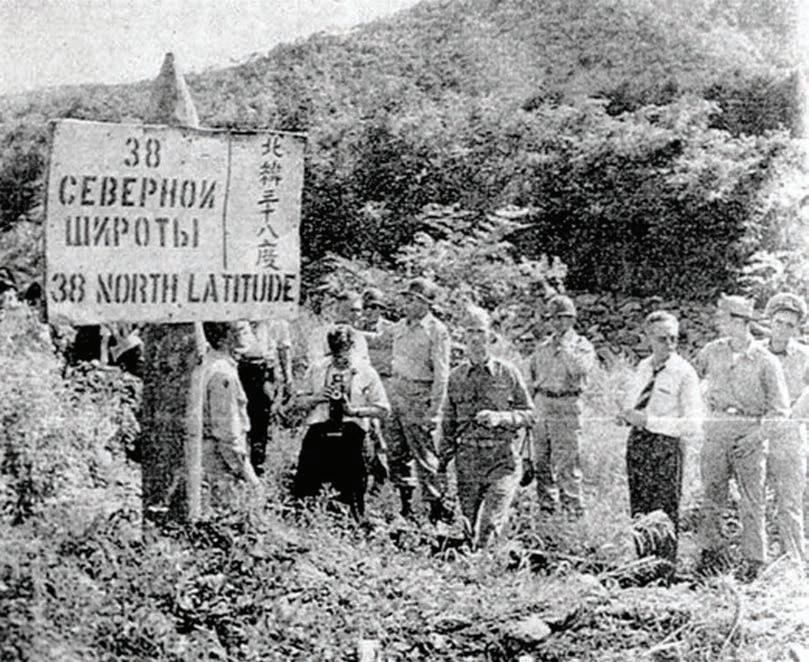
“ … OnAugust8th, 1945, twodaysfollowingtheUSatomicbombingonHiroshima, theSovietUniondeclaredwaronJapanandentered theKoreanPeninsula. TheUS, desperatetocontaincommunistinfluenceandretaintheirpositiononthehighlygeopoliticalpeninsula, suggestedsplittingKoreaalongthe38thParallel, eachsidebeginningatrusteeshipwiththeirhalf, andultimatelyworkingtowardsstabilizing andreunitingthetwohalves. Unfortunately, intheprocessoffurtheringtheirforeignagenda, theUSandSovietUnion’sincreasedtensionled themtorefusetoacknowledgethewantsofthepeople, fosteringanenvironmentofunrestandintenseyearningforreunification(Matray). …
pressurized them into supporting the South Koreans because if they didn’t participate they would be risking a global trend of new aggressive action elsewhere (Vergun). This concern influenced them to send 348,000 US soldiers, but also to (additionally) lobby the UN for military materials and personnel (Walker). Not only did their endeavor to reverse the advances of the North Korean forces prove successful, but they
ideological ideals (Zhihua). Disregarding the forewarning from China, the US crossed the 38th Parallel on October 9th, 1950, influencing China to join the North Korean effort and creating an equalizing force in the war that led to the eventual armistice agreement and stalemating (The Korean War Chronology).
In reflection to my studies on the Korean War, I can witness how international intervention can tear a country apart, the
to the 1970’s, an economic rebirth in South Korea, Soon Hee had the opportunity to attend college for a degree in Fashion Design, a rarity for women in traditional Korean Society at the time (Koo).
One day, while in college, Soon Hee met a generous, dashing American flight medic who was returning to his base in Daegu. He had been bussing his way back to his station when he decided to halt his journey to enjoy some food. However, he
disproportionately bought surplus, so he shared some with a group of unfamiliar college students. When he returned to his base, Soon Hee (one of the students) had left a note for him to find a time to meet, initiating the beginning of genuine friendship. They began seeing each other and doing various activities such as volunteering at a local orphanage. However, after dating for 7 months, he was deported back to the US and they experienced the difficulties of a long-distance relationship. They maintained contact by conversing through letters until after Soon Hee graduated from college, when she migrated to the US with the “American Dream” of love and a more secure, comfortable, free life. Soon after, my grandparents were married in the April of 1974 and had two children (Glover). However, Soon Hee soon discovered discontentment in the gilded life she had imagined as a military wife and, after divorcing, she became disconnected and unpresent in the lives of her children. My grandparents retained contact until 1979 however they lost communication until 2013 when my mother found her in the Windsor Gardens Convalescent Center in Anaheim, California. She was ward of the state for the past 26 years, after a car accident where the doctors discovered brain tumors, without any family visitors, without cognitive and physical control, and with the only nourishment coming from a feeding tube. We quickly moved her across the country to our local community nursing home where we were able to provide her with loving care and enabled her to pass with dignity in the presence of estranged children.
Although I didn’t know her, I imagine what reality would have been like, if she had a greater influence in my life, if her presence would have enabled me to rekindle my lost Korean identity, and if her connection would allow me to feel a part of my Korean ancestry. While I continue to distinguish the person I am becoming, I reflect back to the Korean War comprehending how it laid the groundwork for my blended existence.
AspenMeyer
[
독자시단 (詩壇)]
인생(人生)
전후반(前後半) 분별(分別)
곡천(谷泉) 박원희(朴元喜) <뉴저지 레오니아 거주 프라미스교회 장로 미주 크리스찬문학가협회 회원>
“
… 인생 후반은 바빠지고 / 초조(焦燥)하여 지면서 / 아쉬움 만 가득하여라 // 세상사(世上事)가 다 그렇다지만 / 영성체 (領聖體)의 영생복락(永生福樂) 위하여는 / 인생후반이 유일 무이(唯一無二)의 마지막 기회로다.”
청춘(靑春)은 힘 있고 여생(餘生)이 멀리보여
재기(再起)의 기회(機會) 여유(餘裕)가 있기에
젊어 고생(苦生)은 사서라도 하렸지만
미개(未開)의 시대(時代)에는
나이 60도 장수(長壽)라 칭하여
잔치상도 심히 받았건만
세상(世上)이 발달(發達)하고
춘추(春秋)가 80이 되고보니
100에또 심히 가까워젔나이다
남은 여생이 가까운
이웃 사촌이 되고보니
당장에 마음이 조급(躁急) 하여라
인생 후반은 바빠지고
초조(焦燥)하여 지면서
아쉬움만 가득하여라
세상사(世上事)가 다 그렇다지만
영성체(領聖體)의 영생복락(永生福樂) 위하여는
인생후반이 유일무이(唯一無二)의 마지막 기회로다
사업체 보험 ABC골프장(GolfCourse)은 무슨
보험을 드나?
등산, 낚시, 스키, 골프, 등 여
가를 즐기는 레크레이션이 여러
가지 있지만, 그 가운데 골프는
특히 한국 사람들의 정서에 잘 맞
는 레크레이션의 한 종목인 것 같
다. 미국 내 이름난 골프장에 가
보면 어디를 가나 우리 동포들의
모습과 음성을 들을 수 있고, 동
포사회의 여러 가지 모임에서도
골프를 모르는 사람은 소외감을
느낄 정도로 골프 이야기가 화제
의 중심이 되는 현상을 보면, 더 욱 그렇다는 생각이 든다. 사람들이 골프를 왜 좋아하는
지 그 이유는 여러 가지가 있겠지
만, 나는 매 홀(EachHole)마다
다시 새롭게 시작한다는 것, 그리
고 다시 새롭게 시작할 수 있는
기회가 18번이나 주어진다는 것
이 내가 골프를 좋아하는 이유라
고 말하고 싶다. 골프는 단순한 신체적 운동이
상의 그 무엇, 즉 정신적인 요소
가 있어서 정신게임(Mental Game)이라고 말하기도 한다.
또한 골프는 치는 사람에게 인 생의 진리를 가르쳐주는 측면도
있고, 골프를 함께 쳐보면, 함께
치는 사람들의 인격과 성격도 엿
볼 수 있다. 구글 자료에 의하면 미국에 있
는 골프장의 숫자는 전세계의 모
든 골프장의 40% 이상에 달한다
고 한다. 미국 내 골프장 수는 1만
7,000개 정도인데, 이 가운데 가장
많은 골프장이 있는 주는 단연 플
로리다(1,250개)이고, 이밖에 캘
리포니아(968), 미시간(852), 텍사
스(861), 뉴욕(857) 등이 많은 골
프장이 있으며, 노스 다코타, 알
라스카, 메인, 등은 다른 주에 비 해 골프장이 많지 않다고 한다.
◆ 일반 사업체보험과 비슷
현재 새로 짓고 있는 골프장의 60%는 주택가의 일부(Partofa residentialcommunity)로 개발
것은 일반 사업체를 보험에 드는 것과 별로 다르지
되고 있고, 기존 골프장의 22%는 골프 커뮤니티의 일부(Partofa golfcommunity)라고 한다. 요즈음 한인들이 소유한 골프 장도 꽤 많은 듯한데, 골프장을 소유한다는 것이 보기에 멋있는 것처럼 모든 경우에 반드시 실속 이 있는 것은 아닌 듯하다. 골프장을 보험에 드는 것은 일 반 사업체를 보험에 드는 것과 별 로 다르지 않다. 즉 일반 사업체 를 보험에 들 때 사용하는 상용재 산과 책임(CommercialProperty andLiability)에 대한 묶음보험 (PackageInsurance)에 골프장 에 특유한 여러 가지 재산과 책임 에 대한 커버리지를 짜맞추는 것 에 불과하기 때문이다.
골프장의 재산에 대한 보험은 클럽 하우스(ClubHouse), 프로 샵(ProShop), 관리건물 및 부속 시설(MaintenanceBuildings andotherstructuressuchas benches, ballwashers, course markers, fences, nets, outdoor signs, pavedwalkways, paved cartpaths, patios, andbridges), 골프 코스(GolfCourseincludes trees, plants, shrubs, greens, tees, fairways, roughs, driving ranges, puttinggreens, sand traps, andbunkers), 등을 여러 가지 위험요소(Perils=Causesof Loss)에 대해서 보험을 드는 것 이다.
이밖에도 잔디보험(Lawn Coverage: greens, teesandcut fairways), 골프 코스 건조물 (GolfCourseProperty: foot bridges, retainingwalls, fences, undergroundsprinklers, holeor
teemarkers, benches, water coolers, ballwashers, pinsand holecups, exteriorlightpoles, pavedwalksandpatios), 골프 카트 및 골프장 관리도구(Golf CartsandGrounds MaintenanceEquipment), 음식 물(PerishableStocksuchas refrigeratedfoodservice stock), 홀인원보험(Hole-InOneCoveragewhenaward proceduresareestablished), 등 이 추가될 수 있다. ◆ 골프장의 위험 요소 골프장의 재산에 적용되는 여 러 가지 위험요소는 상용재산보 험에서 말하는 화재(Fire), 번개 (Lightning), 폭발(Explosion), 폭풍우(WindstormorHail), 연 기(Smoke), 비행기 또는 차량 (Aircraftor Vehicles), 폭동 (RiotorCivilCommotion), 만행 (Vandalism), 소화분수장치 누 출(SprinklerLeakage), 공동화 한 지반의 무너짐(Sinkhole Collapse), 화산활동(Volcanic Action), 등과 같은 것인데, 지진 (Earthquake), 홍수(Flood), 허 리케인(Hurricane), 등으로 인한 손실에 대해서도 일정한 한도의 보험을 들 수 있다.
이러한 여러 가지 손실의 원인 으로 골프장이 파손되어 문을 닫 아야 할 경우 그로인해 벌지 못하 게 될 수입(LossofIncome)도 실제 세금보고 한 만큼 그 범위 내에서(ActualLossSustained) 보험을 들 수 있다.
◆골프장의 책임보험
골프장의 책임에 대한
일반 사업체의 그것과 대동소이 하나, 특히 공해에 대한 책임 (PollutionLiability), 벌레 및 제 초 약에 대한 책임(Pesticides andInsecticidesLiability), 손 님 차량 손상(Vehicle Damage causedbygolfcoursepatrons’ golfballs), 전문가 책임 (ProfessionalLiabilityforGolf Instructorsthatcoversbodily injuryorpropertydamage causedbytherenderingor failuretorenderprofessional servicesasagolfinstructor),
가 보험가입자(Additional Insuredthatincludesgolfpro, golfcartusers, clubmembers andvolunteers),
718-939-0900
edit@newyorkilbo.com

